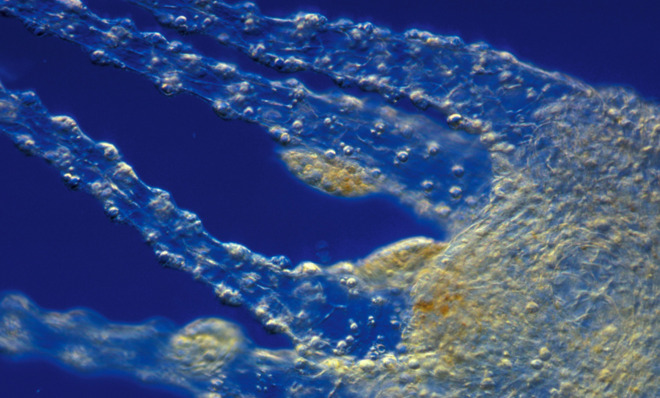Meet Hydra, the shape-shifting Dr. Manhattan of the animal kingdom
This freshwater organism is evidence that what doesn't kill you really does make you stronger


In the comic series Watchmen, physicist Jon Osterman is blown apart in a science experiment gone awry. But his "consciousness" is able to pull his body back together atom by atom, becoming the radiating, blue-skinned Dr. Manhattan. It took him months to reform, and in that time I wonder if he learned that trick from a tiny pond animal. For few creatures in fiction, and even fewer in real life, are capable of surviving being ripped to bits. But for hydras, it is an everyday affair.
Hydras are tiny freshwater animals, with column-shaped bodies ringed at the top with tentacles around a mouth. Like little freshwater sea anemones, hydras spend much of their time with tentacles extended, waiting for prey to pass. Not exactly comic book material. But to see their true power, all you have to is blend a Hydra to hamburger meat and swirl the puree to the bottom of a bowl.
Slowly, the disembodied pieces will begin crawling together, rising like tiny volcanoes from the sea of shredded remains. Forms will begin to take shape. Mouths and skinny tentacles stretching out into the water, and suddenly little bodies everywhere have regrown.
The Week
Escape your echo chamber. Get the facts behind the news, plus analysis from multiple perspectives.

Sign up for The Week's Free Newsletters
From our morning news briefing to a weekly Good News Newsletter, get the best of The Week delivered directly to your inbox.
From our morning news briefing to a weekly Good News Newsletter, get the best of The Week delivered directly to your inbox.
Ulrich Technau of the University of California at Berkeley and his colleagues wanted to find out what gives hydras this incredible ability. The secret, they discovered, to surviving being blown apart is all about keeping its head.
The Hydra's head isn't much to look at. It has a mouth and some tentacles. But instead of housing brains, hydras use their heads to constantly send signals telling the rest of their cells where to go and what to be. When a hydra is turned into puree, its head is scattered into bits. But if even a few cells keep their identity as head cells, that is all a hydra needs to regrow.
According to the Technau and his colleagues, hydra need is between five and 20 of these command cells to form a new body. These cells will take charge, barking out cellular orders that pull the rest of the cells in line. Once a cellular mound has formed around these command cells, it is just a matter of each member of the mound falling into place, and a new animal has grown where before there was only mincemeat.
Because there are many more than 20 cells in the original hydra head, and because these cells will be spread haphazardly when the animal is ground down, these cells will command multiple mounds to form and make new bodies. One animal becomes many.
A free daily email with the biggest news stories of the day – and the best features from TheWeek.com
For the hydra at least, this neat trick may mean fast recovery from predator attacks in the wild. If even a small piece is left after being eaten alive, there is hope of survival. But does it have any implications for those of us who, as a general rule, do not survive being blown to bits? If any, the implications are limited. We do not have an organizing center like hydra (at least not as adults), and so we are not going to find re-assembly quite so easy.
Unless, of course, we're blown apart in the same mad science experiment that disintegrated Jon Osterman. Few will ever be as lucky as Dr. Manhattan and the minuscule hydra.
More from The Conversation...
-
 Alaa Abd el-Fattah: should Egyptian dissident be stripped of UK citizenship?
Alaa Abd el-Fattah: should Egyptian dissident be stripped of UK citizenship?Today's Big Question Resurfaced social media posts appear to show the democracy activist calling for the killing of Zionists and police
-
 Biggest political break-ups and make-ups of 2025
Biggest political break-ups and make-ups of 2025The Explainer From Trump and Musk to the UK and the EU, Christmas wouldn’t be Christmas without a round-up of the year’s relationship drama
-
 Why 2025 was a pivotal year for AI
Why 2025 was a pivotal year for AITalking Point The ‘hype’ and ‘hopes’ around artificial intelligence are ‘like nothing the world has seen before’